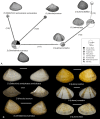Identification and Distribution of Wedge Clams (Donacidae: Bivalvia) in Thailand by Geometric Morphometric and Molecular Analysis
- PMID: 37034829
- PMCID: PMC10076522
- DOI: 10.6620/ZS.2022.61-82
Identification and Distribution of Wedge Clams (Donacidae: Bivalvia) in Thailand by Geometric Morphometric and Molecular Analysis
Abstract
The phylogenetic relationship of living Thai Donacidae was herein studied. Two methodologies, geometric morphometrics (GM) and genetic analysis of COI sequences, were combined and applied to identify the valid taxa and explain biodiversity and the distribution pattern in this family. A total of 587 living specimens were tested to analyze the shape and size patterns by Elliptic Fourier Analysis (EFA). Shell identification and GenBank sequences were added to construct the phylogenetic relationship and haplotype network. Centroid size was used to identify the specimens to the subgenus level. Donax (Hecuba) scortum, was easily distinguished from other species by Principal Component analysis (PCA) of shell size and shape. Donax (Dentilatona) incarnatus and Donax (Deltachion) semisulcatus semisulcatus were identified using Canonical Variates Analysis (CVA). Pairwise comparison of EFA was used for species level recognition, particularly shape overlap was observed for medium and small shell size. Based on genetic distance and haplotype network of COI sequences, Donax (Latona) faba and D. (Latona) solidus could be grouped in the same clade. Intraspecific and interspecific genetic data variation of some common species in different geographical localities of Thailand was observed. Three distribution patterns of Donax species were observed along the two-marine system of Thailand.
Keywords: Bivalve; COI; Donax; Elliptic Fourier shape analysis; Thailand.
Figures














Similar articles
-
Sequence characterization of the 5S ribosomal DNA and the internal transcribed spacer (ITS) region in four European Donax species (Bivalvia: Donacidae).BMC Genet. 2018 Oct 26;19(1):97. doi: 10.1186/s12863-018-0684-x. BMC Genet. 2018. PMID: 30367592 Free PMC article.
-
First complete female mitochondrial genome in four bivalve species genus Donax and their phylogenetic relationships within the Veneroida order.PLoS One. 2017 Sep 8;12(9):e0184464. doi: 10.1371/journal.pone.0184464. eCollection 2017. PLoS One. 2017. PMID: 28886105 Free PMC article.
-
Descriptions of Mikrocytos veneroïdes n. sp. and Mikrocytos donaxi n. sp. (Ascetosporea: Mikrocytida: Mikrocytiidae), detected during important mortality events of the wedge clam Donax trunculus Linnaeus (Veneroida: Donacidae), in France between 2008 and 2011.Parasit Vectors. 2018 Mar 2;11(1):119. doi: 10.1186/s13071-018-2692-0. Parasit Vectors. 2018. PMID: 29499746 Free PMC article.
-
Use of shape to distinguish Chamelea gallina and Chamelea striatula (Bivalvia: Veneridae): Linear and geometric morphometric methods.J Morphol. 2006 Dec;267(12):1433-40. doi: 10.1002/jmor.10489. J Morphol. 2006. PMID: 17103393
-
Geometric morphometrics and molecular systematics of Xanthocnemis sobrina (McLachlan, 1873) (Odonata: Coenagrionidae) and comparison to its congeners.Zootaxa. 2016 Feb 9;4078(1):84-120. doi: 10.11646/zootaxa.4078.1.9. Zootaxa. 2016. PMID: 27395965
References
-
- Abbott RT. 1974. American Seashells, Van Nostrand Rheinhold, New York, USA.
-
- Ackerly S. 1992. The structure of ontogenetic variation in the shell of Pecten. Palaeontology 34:847–867.
-
- Akberali HM, Trueman E. 1985. Effects of environmental strees on marine bivalves molluscs. Adv Mar Biol 22:101−198.
-
- Alyakrinskaya IO. 2005. Functional significance and weight properties of the shell in some mollusks. Biol Bull 32:397−418. doi:10.1007/s10525-005-0118-y. - PubMed
-
- Ambarwati R, Faizah U. 2017. Colour and Morphometric Variation of Donacid Bivalves from Nepa Beach, Madura Island, Indonesia. Biosaintifika 9:466−473. doi:10.15294/biosaintifika.v9i3.11267.
LinkOut - more resources
Full Text Sources
